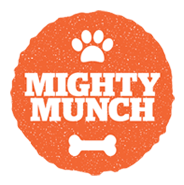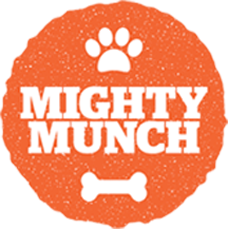Your dog’s health starts with a happy mouth, but dental problems are one of the most overlooked issues in canine care. While your furry friend may seem healthy on the surface, dental disease can develop silently, leading to discomfort, pain, or even serious health complications if left untreated.
In fact, studies show that over 80% of dogs develop some form of dental disease by the age of three. Not only can these issues be distressing and uncomfortable for your dog, but they can also end up costing a lot of money in expensive vet bills!
Ultimately, prevention is the best treatment when it comes to fighting dental disease in dogs. In this guide, we’ll explain how to tell if your dog has dental problems, how to recognise dog dental disease symptoms, and what you can do to prevent your dog’s symptoms from worsening.
One of the easiest, most effective preventative measures is dog dental chews, which strip away plaque, fight bad bacteria, and help prevent the progression of dental disease in dogs. Start your dog on a premium dental chew from Mighty Munch for fresher breath and whiter, cleaner teeth!
Why Pet Parents Need to Stay Vigilant for the Signs of Dental Problems in Dogs
Before we talk about how to tell if your dog has dental problems, why is it important? It’s easy to overlook your dog’s oral care, but it’s such an important aspect of their overall health.
Proper dental hygiene can prevent pain, keep your dog comfortable, and avoid potentially severe health issues later in life. Here’s why it’s so important to understand the signs of dental disease in dogs.
The Importance of Canine Dental Health
Just like us, dogs rely on their teeth for essential daily activities such as eating, playing, and exploring the world. Healthy teeth and gums are vital for their quality of life. Neglecting dental care can lead to tartar buildup, gum disease, tooth decay, and even systemic infections that affect major organs.
Dog Dental Issues Are More Prevalent Than You May Think!
Dental disease in dogs is surprisingly common. According to veterinary experts, periodontal disease is one of the most frequently diagnosed health problems in dogs, with a staggering majority showing dog dental issues symptoms by the age of three.
Unfortunately, many of these issues go unnoticed by pet parents, allowing them to progress into serious conditions. By staying vigilant, you can catch problems early and start dental disease prevention for dogs to protect your pup from more harmful, painful conditions.
Why Dogs Hide Their Pain
Dogs have a natural instinct to hide signs of pain or weakness, a survival trait passed down from their wild ancestors. This means that your dog may suffer from significant dental discomfort without showing obvious signs.
Subtle behavioural changes, such as avoiding hard foods, being less playful, or pawing at their mouth, may be the only indicators of a problem. Pet parents need to be especially attentive to these small but telling clues.
Prevention is Always Better Than Cure
The best way to protect your dog from dental problems is through regular preventive care. Brushing their teeth, providing dental treats or toys, and scheduling routine cleanings can all help ward off oral health issues.
Preventive measures are not only more cost-effective but also spare your furry friend from unnecessary pain and invasive treatments down the road. With proper prevention, you can protect your pup from the worse, more painful stages of dental disease in dogs.
How to Tell if Your Dog Has Dental Problems: 8 Signs of Dental Disease in Dogs to Watch Out For
So, what are the signs of dental disease in dogs? Recognising the dog dental disease signs early can help you address issues before they become severe, ensuring your pup stays healthy and pain-free. Here’s how to tell if your dog has dental problems.
Bad Breath (Halitosis)
While your dog’s breath may never smell minty fresh, a foul or unusually strong odour can be a sign of dental disease. Halitosis is often caused by bacteria buildup in the mouth, which can indicate gum disease or tooth decay. If your dog’s breath suddenly becomes noticeably unpleasant, it’s time to investigate further.
Discoloured Teeth or Visible Tartar
Healthy teeth should appear white and clean. Yellow or brown discolouration, often caused by tartar buildup, is one of the most obvious dog dental disease signs. Over time, untreated tartar can lead to gum disease and other complications. Regular inspections of your dog’s teeth can help you catch this issue early.
Red, Swollen, or Bleeding Gums
Inflamed or bleeding gums are common signs of plaque on dog’s teeth or dental disease in dogs. Healthy gums should be pink and firm, not red, swollen, or prone to bleeding. Check your dog’s gums regularly, especially if they’re showing signs of discomfort during meals or playtime.
Difficulty Eating or Chewing
If your dog starts eating less, avoids hard foods, or appears to chew awkwardly, it could indicate dental pain. Watch for signs such as dropping food, chewing on one side of the mouth, or avoiding their favourite treats. These behaviours often point to underlying dental problems that need attention.
Pawing at the Mouth or Drooling
Excessive drooling or frequent pawing at the mouth can signal discomfort or pain. Dogs may exhibit these behaviours if they have something stuck in their teeth, a tooth infection, or gum irritation. Don’t dismiss these actions - they’re often your dog’s way of telling you something is wrong.
Loose, Broken, or Missing Teeth
Loose or missing teeth in adult dogs are not normal and often result from advanced periodontal disease or trauma. Broken teeth can also cause pain and increase the risk of infection. Regularly checking your dog’s teeth can help you spot these issues before they worsen.
Swelling Around the Face or Jaw
Facial swelling, especially around the jaw or under the eyes, may indicate an abscessed tooth or a severe oral infection. These more severe dog dental issues symptoms require immediate veterinary attention to prevent further complications, such as the infection spreading to other parts of the body.
Behavioural Changes
Dental problems can cause significant discomfort, leading to changes in your dog’s behaviour. Look for signs such as increased irritability, withdrawal, or reluctance to play or interact. These changes could mean many things, but they might be signs of dental disease in dogs.
What to Do if You Notice the Dog Dental Issues Symptoms
So, we’ve explained how to tell if your dog has dental problems, but what should you do if you start to see these dog dental disease signs in your pup? The most important thing to remember is to act quickly, as these dog dental disease symptoms only get worse with time.
Schedule a Veterinary Appointment Immediately
Whenever you start to see signs of dental problems in dogs, it’s important to call your vet right away. Dental issues can range from mild tartar buildup to severe infections or abscesses, and only a professional can provide an accurate diagnosis.
During the appointment, your vet will likely perform an oral exam and may recommend dental X-rays to assess the severity of the problem. Early intervention can prevent further complications and help your dog return to their happy, pain-free self.
Treatment Options for Dog Dental Problems
Your vet will determine the best treatment for your dog, based on the specific dog dental disease signs your pup shows. For mild to moderate dental disease, your vet may recommend professional cleaning to remove tartar and plaque.
Performed under anesthesia, a professional cleaning is usually considered the best way to keep dogs teeth clean, but the cost of dog dental cleaning is not insignificant. In terms of how often to get dogs teeth cleaned, professional cleanings are recommended at least once a year.
If your dog has more serious dog dental disease symptoms, your vet may take more drastic measures like tooth extractions. Can dogs get dental implants? Yes, but this is usually reserved for extreme situations where other treatments have failed.
Your vet will guide you on the best course of action based on your pup’s dog dental disease symptoms, and explain all the necessary post-care steps, including helping you identify the best soft foods for dogs after dental surgery.
Implementing an At-Home Dental Care Routine
As well as seeking professional care, it’s essential to implement at-home dental care for your pup. There are lots of steps you can take, including brushing your dog’s teeth with toothpaste, making DIY dog dental chews, and focusing on natural, healthy foods.
Dental sticks are a popular option, but are dental chews good for dogs teeth, or are dental sticks bad for dogs? Actually, they’re one of the best preventative treatments out there. In terms of brushing dogs teeth vs dental chews, chews are almost as effective, and much easier and gentler for both you and your pup.
How do dog dental sticks work, exactly? As your dog chews, the stick breaks down, and the gritty components scrape plaque and tartar from your dog’s teeth. What do dental chews do for dogs besides removing plaque? Many also contain ingredients that freshen your dog’s breath and fight bad bacteria.
At Mighty Munch, we have the best dental chews for dogs, coated with a potent dog probiotic. Our dental sticks are formulated with premium, natural ingredients and free from harmful additives and fillers found in many dental chews. They’re backed by vets, and safe for all breeds and ages.
How many dental chews can a dog have a day? Just one Mighty Munch dental chew a day protects against plaque and tartar. Our chews come in two sizes, and if the smaller size is still too hard for little mouths, you can learn how to soften dog dental chews to make chewing easier.
How often should you brush your dog’s teeth if you’re using a daily dental chew? You should still try to brush your dog’s teeth as often as they’ll let you, but a daily chew means your pup is still fighting plaque and tartar on the days when brushing just isn’t possible. It’s a win-win!
What else can you do for your dog’s at-home dental care? Do dental water additives for dogs work, and does dog dental powder work? While these bring some benefits, there’s no mechanical or chewing aspect, so they don’t scrape plaque as effectively as brushing or dental chews.
What about dietary changes? Are carrots good for dogs teeth? Carrots do naturally clean your dog’s teeth, but they’re not as effective as specifically formulated dental chews or brushing with toothpaste. Are bones good for dogs teeth? Certain hard bones can be beneficial, but may also come with some risks.
At the end of the day, the best at-home treatments to combat signs of dental problems in dogs are regular brushing and a daily dental chew from Mighty Munch. And while you’re at it, make sure you check out our other top-rated Australian dog supplements for happy, healthy, mobile pups!
Closing Thoughts on the Signs of Dental Disease in Dogs
So, that wraps up our guide on how to tell if your dog has dental problems. Recognising the warning signs of dental problems in dogs, such as bad breath, swollen gums, or difficulty eating, can make all the difference in preventing pain and ensuring a better quality of life for your furry friend.
By staying vigilant about dog dental issues symptoms and implementing a consistent at-home dental care routine, you can protect your dog from the discomfort and complications of untreated dental issues.
One of the most effective preventative measures for at-home dental care is Mighty Munch dental sticks. A daily dental chew will help protect your dog against plaque and tartar, which leads to more serious issues like dental disease or tooth loss if left untreated.
Remember, a healthy mouth leads to a happier dog. Start your pup on Mighty Munch dental chews today for healthy, clean, pain-free teeth!


